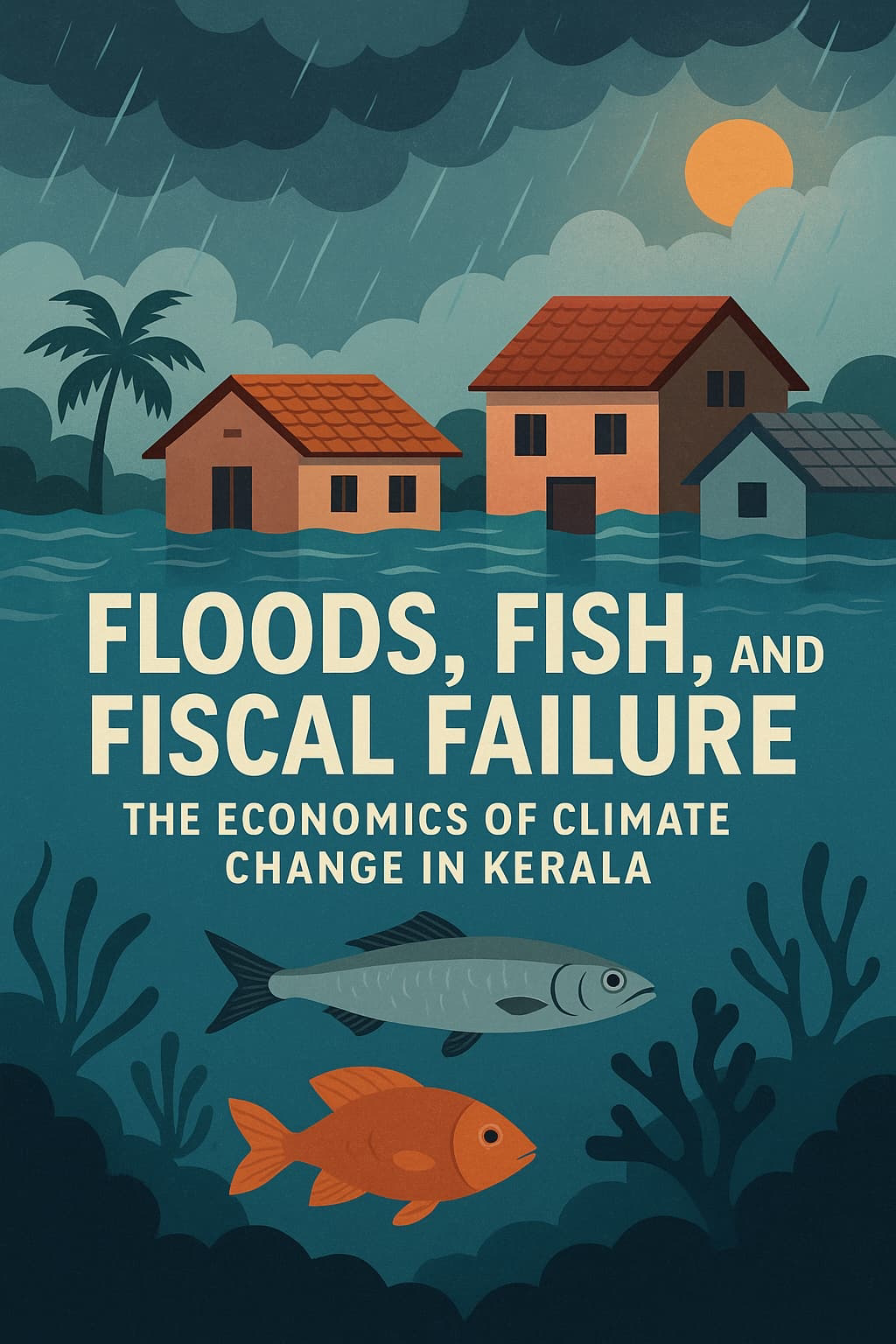Floods, Fish, and Fiscal Failure: The Economics of Climate Change in Kerala
Floods, Fish, and Fiscal Failure: The Economics of Climate Change in Kerala
---
Introduction: Paradise Under Siege
Nestled between the Western Ghats and the Arabian Sea, Kerala is often romanticized as “God’s Own Country.” With its lush backwaters, tropical climate, and high Human Development Index (HDI), Kerala appears as an economic and ecological success story. Yet beneath this surface lies a growing threat that challenges not just its natural beauty but its entire economic architecture — climate change. Increasingly frequent floods, erratic monsoons, coastal erosion, and declining fish stocks are transforming Kerala's economy in profound and often irreversible ways. This article explores how climate change is already reshaping the economic landscape of the state, who is being affected the most, and what the future might look like if timely interventions are not made.
---
The Rising Costs of Nature’s Fury
Kerala has faced a series of climate disasters in recent years. The floods of 2018 were the most devastating in nearly a century, displacing over a million people and causing damages worth ₹31,000 crore. The deluge in 2019 was no less destructive, and even “normal” monsoons now routinely bring landslides and flash floods. For a state with a fragile mountainous terrain and densely populated coastal areas, this pattern is more than a seasonal inconvenience — it’s an existential threat.
What makes Kerala’s situation economically distinct is that the damage is not limited to infrastructure alone. Repeated floods wipe out agricultural production, destroy tourism assets, and paralyse local markets. Farmers in Idukki, Wayanad, and Palakkad face crop failures year after year due to either excessive rainfall or drought-like dry spells. Paddy fields turn barren, pepper vines rot, and cardamom plantations wash away. This erodes both incomes and land value, pushing families into cycles of debt.
The indirect costs are harder to quantify but equally severe: disrupted school years, lost labour hours, migration, mental health breakdowns, and the gradual loss of faith in the sustainability of traditional livelihoods. When a natural disaster becomes a predictable part of life, it forces a fundamental rethinking of economic planning and resource allocation.
---
The Silent Suffering of the Fishing Economy
The coastline of Kerala, stretching over 580 km, is home to nearly 10 lakh people dependent on fishing. Traditionally, fishing has been a backbone of Kerala’s coastal economy, but it is now in crisis. Rising sea temperatures and changing salinity patterns have disrupted marine biodiversity. Fish species that were once abundant — like sardines, mackerel, and anchovies — are now migrating to colder waters or dying off altogether. The Kerala University of Fisheries and Ocean Studies (KUFOS) has reported a 25–30% drop in certain fish populations in the last decade.
Fisherfolk are often the first to experience the real-time impact of climate change. Their daily catch is reduced, fuel costs are higher as they have to travel further into the sea, and frequent cyclones and coastal storms make fishing increasingly dangerous. Moreover, coastal erosion has made many fishing villages uninhabitable, forcing internal displacement. Areas like Chellanam and Alappad have become symbols of slow-motion disaster — where the sea eats into the land a few metres every year, destroying homes, roads, and hope.
What’s worse, most fishing families have little or no social security. Boat owners may receive compensation for damages after disasters, but daily wage labourers — who form the bulk of the community — are left with nothing. Insurance penetration is low, government relief is slow, and alternative employment options are virtually non-existent.
---
The Climate Cost of Tourism
Tourism is a major economic pillar in Kerala, contributing over 10% to its GSDP and employing lakhs of people directly and indirectly. From backwater cruises in Alappuzha to the misty hills of Munnar, the state thrives on its ecological appeal. However, the tourism industry is increasingly vulnerable to climate-induced disruptions.
The floods of 2018 led to a 10% decline in tourist arrivals. Bookings were cancelled en masse, flights rerouted, and entire towns cut off. Many resorts and homestays suffered severe structural damage. Even beyond extreme weather events, long-term climate degradation is affecting Kerala’s appeal. For example, the rise in sea levels is altering the dynamics of its famous backwaters. In places like Kuttanad, saltwater intrusion has made previously freshwater areas unsuitable for both tourism and agriculture.
Tour operators and small business owners have begun expressing anxiety over these shifts. Their income is seasonal and volatile, and climate change adds a new layer of uncertainty. Without adaptive infrastructure — elevated walkways, flood-proof lodges, eco-restoration of tourist sites — Kerala risks losing its competitive edge in a rapidly changing travel industry.
---
Public Health and Productivity
Another angle often ignored in economic assessments of climate change is the impact on public health. Warmer temperatures and erratic rainfall create ideal conditions for the spread of diseases like dengue, chikungunya, and leptospirosis — all of which have seen spikes in recent years. Hospitals across the state report surges in climate-sensitive illnesses during the monsoon months.
This is not just a healthcare issue; it’s an economic one. Illness reduces labour productivity, increases out-of-pocket medical expenses, and places stress on government health infrastructure. For a state already grappling with an ageing population and rising pension liabilities, this is a time bomb ticking silently.
Moreover, heat stress — especially in northern districts — is reducing the number of viable work hours, particularly for daily wage workers in construction, agriculture, and transportation. The phenomenon of “climate gentrification” is slowly setting in, where only the well-off can afford to insulate themselves from the effects of a hotter, riskier climate.
---
Infrastructure: Built for Yesterday
Kerala’s infrastructure, from its narrow roads to its fragile dams and drainage systems, was not built for a world of climate extremes. The state’s famed road density is now a curse during floods, with frequent blockages and collapses. Low-lying areas like Kuttanad and Kochi are facing near-permanent waterlogging due to urban sprawl and poor drainage planning.
The public transportation system, especially the Kerala State Road Transport Corporation (KSRTC), suffers massive losses during disasters. The cumulative cost of repairs to roads, bridges, and public buildings after each flood season is staggering. Yet there is little movement towards climate-proofing infrastructure through sustainable design and resilient materials.
Power infrastructure is another concern. While Kerala’s dependence on hydropower has been a source of renewable energy pride, it also exposes the state to risk. Droughts reduce water levels, while excess rainfall forces dam openings that flood downstream villages. Decentralised solar power and microgrids could offer alternatives, but the investment has been slow and uneven.
---
Agriculture: A Sector in Shock
Kerala’s agriculture, dominated by cash crops like rubber, coconut, and spices, is especially vulnerable to climate variation. Rubber yields fluctuate with rainfall, pepper is sensitive to both drought and fungal infections, and coconut trees are dying from rising soil salinity. The younger generation is already moving away from farming due to low returns and high risk, and climate change is accelerating this abandonment.
The result is a growing dependence on food imports. Kerala now imports over 80% of its rice and vegetables from other states. This makes the state vulnerable not only to price shocks but also to transport disruptions during floods. Ironically, a state with some of the highest rainfall in India is facing chronic water management problems, with both floods and droughts often occurring in the same year.
The government’s various initiatives — such as the Subhiksha Kerala programme — have attempted to boost local cultivation, but without addressing the underlying climate threats, these schemes offer only temporary relief.
---
Inequality Amplified by Climate
Perhaps the most insidious effect of climate change in Kerala is its amplification of inequality. The poorest, who live in the most vulnerable areas — coastal belts, hilly slopes, riverbanks — bear the brunt of the damage. They have fewer resources to relocate, rebuild, or adapt. Relief packages, when they come, are often insufficient or unevenly distributed.
Wealthier households can afford to buy insurance, move to safer zones, install backup generators, and adapt their lifestyles. Poorer communities, by contrast, experience a compounding effect of every disaster: asset loss, income loss, displacement, debt, and social stigma.
Climate resilience, therefore, cannot be just about engineering solutions; it must also be about social justice.
---
Policy Paralysis and Political Myopia
Despite multiple climate studies, expert warnings, and disaster reports, Kerala’s policy response remains reactive rather than proactive. Master plans for flood control or coastal zone management gather dust in bureaucratic offices. Climate adaptation budgets are scattered across departments with little coordination. Environmental Impact Assessments are often seen as hurdles to bypass rather than tools for sustainability.
Moreover, political cycles discourage long-term investments. Politicians prefer visible, populist interventions — such as ex-gratia payments or building new houses — over complex projects like watershed management or urban zoning reforms. The tragic irony is that these short-term measures often increase long-term vulnerability.
---
Hope in Local Innovation and Community Action
But not all is gloom. Across Kerala, communities, scientists, and startups are taking matters into their own hands. In Alappuzha, floating vegetable gardens have been developed to cope with waterlogged lands. In Kozhikode, climate-smart classrooms powered by solar energy are being piloted. NGOs are working with fishing communities to create early warning systems and teach sustainable fishing practices.
Women’s self-help groups under Kudumbashree are promoting climate-resilient crops and disaster preparedness. Local self-governments in places like Perumbavoor and Meenangadi have developed climate action plans, focusing on rainwater harvesting, reforestation, and sustainable waste management.
These micro-solutions, if supported with policy and funding, could scale into macro transformations.
---
Conclusion: Choosing Between Crisis and Change
Kerala’s battle with climate change is not just environmental — it is deeply economic. Every monsoon that floods a village, every storm that breaks a boat, every fish that vanishes from the coast, is a loss measured in lives and livelihoods. Yet this crisis is also an opportunity. Kerala, with its educated populace, strong decentralised governance, and history of social innovation, can lead India in building a climate-resilient economy.
But this will require courage. It means saying no to unregulated construction, no to sand mining mafias, no to political denialism. It means investing in green jobs, retrofitting cities, and overhauling outdated infrastructure. It means recognising that climate justice is not a charity — it is an economic necessity.




Comments
Post a Comment